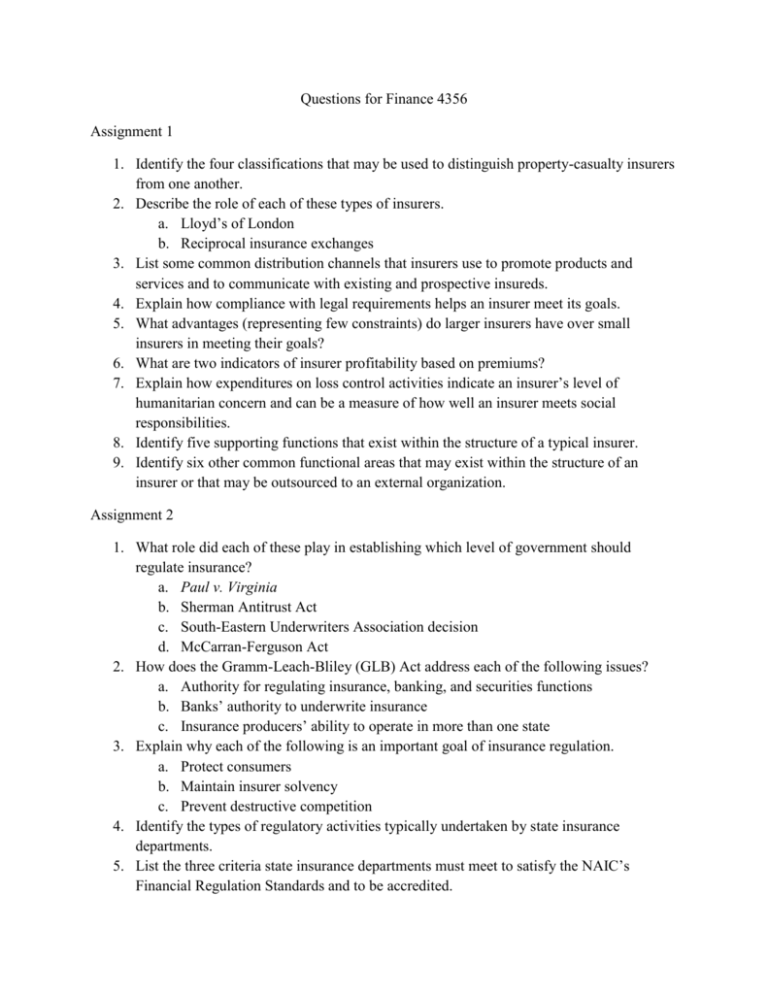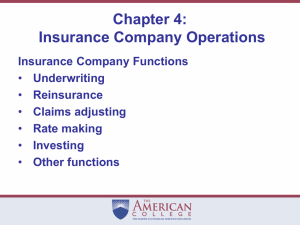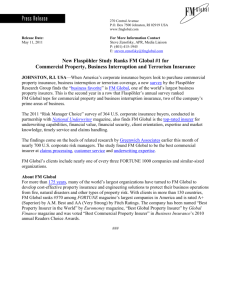Test Questions
advertisement

Questions for Finance 4356 Assignment 1 1. Identify the four classifications that may be used to distinguish property-casualty insurers from one another. 2. Describe the role of each of these types of insurers. a. Lloyd’s of London b. Reciprocal insurance exchanges 3. List some common distribution channels that insurers use to promote products and services and to communicate with existing and prospective insureds. 4. Explain how compliance with legal requirements helps an insurer meet its goals. 5. What advantages (representing few constraints) do larger insurers have over small insurers in meeting their goals? 6. What are two indicators of insurer profitability based on premiums? 7. Explain how expenditures on loss control activities indicate an insurer’s level of humanitarian concern and can be a measure of how well an insurer meets social responsibilities. 8. Identify five supporting functions that exist within the structure of a typical insurer. 9. Identify six other common functional areas that may exist within the structure of an insurer or that may be outsourced to an external organization. Assignment 2 1. What role did each of these play in establishing which level of government should regulate insurance? a. Paul v. Virginia b. Sherman Antitrust Act c. South-Eastern Underwriters Association decision d. McCarran-Ferguson Act 2. How does the Gramm-Leach-Bliley (GLB) Act address each of the following issues? a. Authority for regulating insurance, banking, and securities functions b. Banks’ authority to underwrite insurance c. Insurance producers’ ability to operate in more than one state 3. Explain why each of the following is an important goal of insurance regulation. a. Protect consumers b. Maintain insurer solvency c. Prevent destructive competition 4. Identify the types of regulatory activities typically undertaken by state insurance departments. 5. List the three criteria state insurance departments must meet to satisfy the NAIC’s Financial Regulation Standards and to be accredited. 6. Insurance regulation occurs primarily at the state level, but the issue of federal regulation is often raised. a. What arguments have been advanced in favor of federal regulation? b. What arguments have been advanced in favor of continued regulation by the states? 7. Explain the difference between an admitted and a nonadmitted insurer. 8. Describe the purpose of state guaranty funds. 9. Compare the arguments for prior-approval systems versus competitive rating systems. 10. Explain how financial rating organizations act as unofficial regulators of insurers. Assignment 3 1. 2. 3. 4. 5. 6. List the five characteristics that distinguish types of insurance customers. Explain how predictive analytics are used in market research. Describe four common bases of market segmentation. Why is ownership of expiration lists an advantage to an independent agency? Name six methods producers use to locate prospective clients. What considerations relating to existing markets might an insurer evaluate during the process of selecting distribution systems and channels? Assignment 4 1. Describe the approaches underwriters take to minimize the effects of adverse selection. 2. Distinguish between the activities of line underwriters and those of staff underwriters. 3. Explain why it is important that underwriters operate within their assigned levels of underwriting authority. 4. Describe the components of an insurer’s financial capacity. 5. Explain how rapid premium growth can cause insurers to experience excessive premiumto-surplus ratios. 6. Describe the potential advantages of using predictive modeling in making underwriting decisions. 7. What are the steps in the underwriting process? 8. List five principal sources of underwriting information. 9. What four major modifications might an underwriter recommend to make a submission more acceptable? 10. What would an underwriter conclude about each of the following combined ratios? a. A combined ratio of exactly 100 percent b. A combined ratio of greater than 100 percent c. A combined ratio of less than 100 percent 11. An insurer decides to make its underwriting criteria more restrictive. Explain how this change affects premium volume and the insurer’s combine ratio. Assignment 5 1. Compare the principle features of fire-resistive construction with those of noncombustible construction. 2. Why are high-rise buildings a concern to fire underwriters? 3. Describe the factors considered in the determination of a community’s public protection classification. 4. Charles has contracted with Ed to construct a large shopping complex on a fifty-acre site in a rural community. They ask an insurance producer to set up a meeting with an insurance company underwriter before the start of construction to seek suggestions for improving the insurability of the complex and for minimizing the cost of property insurance on it. Describe the fire protection factors that the underwriter should consider in making such suggestions. 5. What are the most common property valuation methods? 6. Identify the insurer benefits associated with encouragement of insurance-to-value provisions. 7. Provide some examples of factors that could affect the duration of a business interruption. 8. What must occur in order for there to be a covered loss of use, loss of business income, or extra expense loss? 9. Identify six factors underwriters analyzing crimes committed by other loss exposures must consider. 10. Why is the legal status of persons likely to be on the premises an important consideration when underwriting commercial general liability loss exposure? 11. What are some of the loss exposures an underwriter would consider for products liability coverage applications? 12. What information should an underwriter have to analyze a commercial automobile submission? 13. What are the characteristics of good fleet safety programs? 14. Why should a workers’ compensation underwriter investigate an applicant’s use of temporary and seasonal workers? 15. What three functions are most umbrella policies designed to serve? Assignment 6 1. Describe how an insurer’s risk control activities can assist in meeting the insurer’s profit goals. 2. Describe the three categories of insurer risk control activities. 3. Describe the premium auditing’s contribution to underwriting. a. Explain the importance of premium auditing in classifying insured exposures. b. Explain the importance of premium auditing in the identification of inadequate exposure estimates. c. Explain the importance of premium auditing in providing information on the desirability of an account. 4. Explain the importance of premium auditing’s verification of classification codes. Assignment 7 1. Describe the primary goals of the claim function. 2. What is the result of actuaries (and insurers) when claim payments are recorded accurately and realistic reserves are set in the insurer’s claim processing system? 3. Identify three circumstances under which claim representatives interact with state insurance regulators. 4. Identify the two types of performance measures used to measure claim personnel performance, and list examples of each. 5. When reviewing coverages, if it is apparent from the loss notice that coverage may not be available for the loss, the claim representatives should prepare either one of which two documents to notify the insured of this concern while still preserving the insurer’s rights? 6. What are two reserving methods that may result in a more realistic reserve and may be used to avoid the problem of stairstepping reserves? 7. What two determinations does the claim representative make based on the facts of the case? 8. Explain why the law of bad faith developed. 9. Describe the two attributes of the insurance contract that contributed to the development of bad-faith claims. 10. Identify the sources that claim representative can use to assist them in making a knowledgeable claim evaluation. 11. Contrast the standards for claim representatives and lawyers in good-faith negotiations. 12. Identify the three critical elements of good-faith claim handling. Assignment 8 1. What questions can claim representatives ask to determine whether fixtures are real property? 2. Identify four exclusions that can complicate the answer to the questions “What are the covered causes of loss?”. 3. When claim representatives determine the answer to “What is the dollar amount of the loss?”, what issues must they consider? 4. Explain how the obligation to provide an inventory for residential personal property claims is met by the insured when written records are unavailable. 5. Why are the values of commercial structures more difficult to determine than the values of residences? 6. Describe the pre- and post-loss activities that can assist insurers when catastrophes occur. 7. Bookseller is an independently owned bookstore located in an urban shopping area. A fire makes the property untenantable, causing a suspension in business operations. Explain the special claim considerations facing the claim representative in handling Bookseller’s business income loss. 8. What are the four steps in handling a liability claim? 9. What determines coverage in a liability claim? Explain the reason for this. 10. Describe the defenses that insurers may use when a claim involves charges of negligence against its insured. 11. Explain the difference between special damages and general damages in bodily injury claims. 12. Under what circumstances does an insurer have a legal obligation to settle? 13. Under what circumstances would a claim representative determine a damaged auto to be a constructive total loss? 14. Describe the standards of care that property owners owe to trespassers, licensees, and business invitees. 15. Describe the actions insurers have taken to control the rising costs of workers compensation related medical expenses. 16. Describe the standard of care to which professionals are held. 17. Refined Insurance Company has been notified that an explosion and fire occurred at a large refinery operated by one of its insureds. The explosion and fire caused extensive injuries to the insured’s employees and to visiting sales representatives. As a result of this loss, Refined will be faced with the settlement of many kinds of losses, including premises liability and workers compensation. Briefly describe the unique elements or problems associated with the settlement of each of these types of losses. Assignment 9 1. Describe the primary goal of ratemaking. 2. Name the three rate characteristics on which regulation is generally based. 3. List the five characteristics that rates should have to enable an insurer to be competitive and make a reasonable profit. 4. Describe the three components of an insurance rate. 5. Explain why an insurer’s loss reserves for liability insurance are usually much greater than it loss reserves for an equivalent amount of property insurance. 6. What factors cause a lag in reflecting loss experience in ratemaking? 7. Danforth Insurance Co. has an auto insurance portfolio consisting of 100,000 insured vehicles in a territory. Danforth analyzes the losses for this portfolio during a three-year period. a. If the amount of incurred losses is $30 million during the three-year period, what pure premium rate should Danforth use? b. Assume that the reserves in the incurred losses are inadequate by $3 million. What should the pure premium rate be? c. If Danforth used the rate based on $30 million in losses, what would Danforth’s loss be the following year, assuming that the $33 million in incurred losses was correct? 8. Identify the two loss ratios used in the loss ratio ratemaking method. 9. Describe the three general categories of data that insurers collect for ratemaking. 10. Identify four ratemaking data aggregation methods. 11. Under the calendar-year method, how are earned premiums calculated? 12. Why does the accident-year method eliminate the largest source of error inherent in the calendar-year method? 13. Describe the special trending problem that exists in workers compensation insurance. 14. Identify the two principal types of loss reserves. 15. Describe the three components of bulk reserves. Assignment 10 1. Briefly define reinsurance. 2. What are the six principal functions that reinsurance performs for primary insurers? 3. What are three ways in which a primary insurer can use reinsurance to stabilize its loss experience? 4. Identify the three sources from which reinsurance may be purchased. 5. Contrast treaty reinsurance and facultative reinsurance. 6. Explain why primary insurers usually make treaty reinsurance agreements so their underwriters do not have to exercise discretion in using reinsurance. 7. Explain how the amount of insurance, the premium, and losses are allocated under a pro rata reinsurance agreement. 8. What are the two most common approaches to handling loss adjustment expenses under an excess of loss reinsurance agreement? 9. Describe how a loss occurrence clause functions within a catastrophe excess of loss reinsurance agreement. 10. Describe the purpose of catastrophe excess of loss reinsurance. 11. For what types of liability insurance is clash cover useful? 12. Describe the type of losses that finite risk reinsurance generally is designed to cover. 13. List and briefly describe some of the more commonly used capital market alternatives to reinsurance. 14. What effect may a wide geographic spread of loss exposures have on an insurer’s reinsurance needs? 15. Why does an insurer that is financially strong need less reinsurance than a financially weaker one? 16. Identify the four factors, in addition to cost, that affect a primary insurer’s retention selection. 17. Identify the five factors related to the selection of reinsurance treaty limits. 18. Liability Insurer is concerned that a disproportionate number of its insureds are located in states where an overly litigious environment has led to numerous successful lawsuits against insureds. How could a reconfigured reinsurance program address this concern? 19. Why are primary insurers usually eager to take credit against their unearned premiums and loss reserves for premiums paid to and losses recoverable form reinsurers? Assignment 11 1. 2. 3. 4. List the five forces that drive competition within an industry. Describe the levels at which strategy is formulated within an organization. Describe the three key strategic reasons why insurers pursue global expansion. Describe the three key areas for an insurer to evaluate in making a strategic decision about expansion into a global market.






